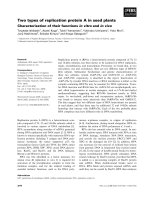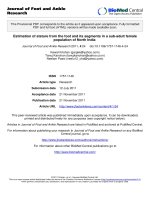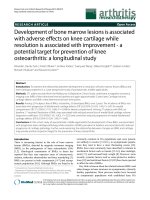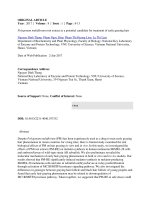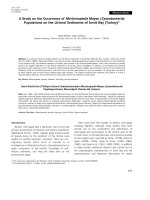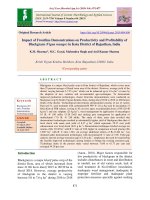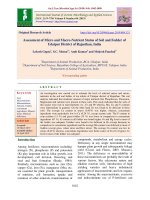Coriander a potential seed spice crop of humid south eastern plains-zone of Rajasthan, India
Bạn đang xem bản rút gọn của tài liệu. Xem và tải ngay bản đầy đủ của tài liệu tại đây (149.82 KB, 7 trang )
Int.J.Curr.Microbiol.App.Sci (2017) 6(4): 2385-2391
International Journal of Current Microbiology and Applied Sciences
ISSN: 2319-7706 Volume 6 Number 4 (2017) pp. 2385-2391
Journal homepage:
Review Article
/>
Coriander a Potential Seed Spice Crop of
Humid South Eastern Plains-Zone of Rajasthan, India
R.K. Bairwa1*, B.L. Dhaka1, M.K. Poonia2, B.L. Nagar3 and C.M. Balai4
1
Krishi Vigyan Kendra, Bundi (Rajasthan) 323 001, India
Krishi Vigyan Kendra, Kota (Rajasthan) 324 001, India
3
Agriculture Research Station, Kota (Rajasthan) 324 001, India
4
Krishi Vigyan Kendra, Dungarpur (Rajasthan) 314001, India
2
*Corresponding author
ABSTRACT
Keywords
Coriander,
Properties,
Cultivation,
Productivity
Article Info
Accepted:
20 March 2017
Available Online:
10 April 2017
Coriander is an annual seed spice crop, which belongs to family Apiaceae. It is native of
Mediterranean region. The aromatic characters of plants are due to presence of linalool
compound in essential oil of seeds. The green leaves of coriander are used in salads and
are a good source of vitamin A and vitamin C. Major active constituents of coriander
essential oils and fatty oil. The essential oil content of the weight of ripe and a dried fruit
of coriander varies between 0.03 and 2.6% and the content of fatty oil varies between 9.9
and 27.7%. Coriander leave showed stronger antioxidant activity than the seeds. Coriander
lowered the blood sugar when added to the diet of diabetic patients. The
antihyperglycemic action of coriander is associated with stimulation of insulin secretion
and enhancement of glucose uptake and metabolism by muscle, reflecting the effects of
more than one active constituent.
Introduction
Rajasthan is the largest coriander producing
state in India and contribute 62% of India’s
total production. It is mainly grown in Hadoti
region of Rajasthan comprising of Kota,
Bundi, Baran and Jhalawar districts and holds
the entire production in Rajasthan. However,
the productivity of coriander is low compare
to its potential yield. Farmers are facing
numerous problems in realizing the full
production potential of coriander. It is
realized that lack of suitable high yielding
variety as well as poor knowledge of
improved production technologies along with
complex disease-pest syndrome, emergence
of new biotypes and races of key pests and
pathogens are major impediments in realizing
the full potentialities of coriander production.
With the development of high yielding, early
maturing, fertilizer responsive varieties are a
new proposition which would ensure stability
and higher profit per unit area of land and has
potential to produce 20-25% higher seed yield
than other existing varieties (Nagar et al.,
2009).
Coriander (Coriandrum sativum L.) is an
annual seed spice crop, which belongs to
family Apiaceae. It is native of Mediterranean
region. The aromatic characters of plants are
due to presence of linolool compound in
2385
Int.J.Curr.Microbiol.App.Sci (2017) 6(4): 2385-2391
essential oil of seeds. The green leaves of
coriander are used in salads and are a good
source of vitamin A and vitamin C. The
young plant leaves as well as the seed are
used for the preparation of chutney and are
also used as seasoning in curries, soup,
sauces, fish sauce and cream sauce for
chicken etc (Janardhan and Thoppil, 2004;
Tiwary and Agarwal, 2004). Besides their use
in culinary, the seeds and leaves are also used
for the treatment of maladies like indigestion,
dyspepsia, flatulence and piles (Dimri et al.,
1976).
Botanical description
Coriander leaves are small herb having many
branches and sub-branches. New leaves are
oval but aerial leaves are elongated. Flowers
are white, having slightly brinjal like shades
while fruit are round in shape (Handa and
Kaul, 1996). Macroscopic characteristic of
fruit is globular, mericarps usually united by
their margins forming a cremocarp about 2-4
mm in diameter, uniformly brownish-yellow
or brown, glabrous, sometimes crowned by
then remains of sepals and styles, primary
ridges 10, wavy and slightly inconspicuous
secondary ridges 8, straight, it has aromatic
odour. It has spicy and characteristic taste
(Handa and Kaul, 1996; Pathak et al., 2011).
Phytochemicals
The general chemical composition present in
coriander fruits are described in table 1.
Major active constituents of coriandrum
sativum are essential oils and fatty oil. The
essential oil content of the weight of ripe and
dried fruits of coriander varies between 0.03
and 2.6% and the content of fatty oil varies
between 9.9 and 27.7%, 1% of the major
component of which is S-(+)-linalool (6070%) other minor active constituents present
in
essential
oil
are
monoterpenes
hydrocarbons viz. α-pinene, limpnene, γ-
terpinene, p-cymene, borneol, citronellol,
camphor, geraniol and geraniol acetate,
heterocyclic components like pyrazine,
pyridine thiazole, furan and tetrahudrofuran
derivatives,
isocoumarins,
coriandrin,
dihydrocoriandrin,
coriandronsA-E,
flavonoids, pthlides, neochidilide, digustilide
phenolic acids and sterols. The composition
of the essential oil is described in table 2
(Diederichsen, 1996; Pathak et al., 2011).
Medicinal and pharmacological properties
Coriander, due to its rich aroma because of its
essential oils, apart from being an excellent
appetizer, helps in proper secretion of
enzymes and digestive juices in the stomach,
stimulates digestion and peristaltic motion. It
is helpful in treating problems like anorexia.
Some of the components of essential oils in
coriander such as borneol and linalool, aid
digestion, proper functioning of liver and
bonding of bowels and help to cure diarrhea.
It is also helpful to treat diarrhea caused by
microbial
and
fungal
action,
since
components like cineole, borneol, limonene,
alpha-pinene and betephelandrene have antibacterial effects. In addition, the fresh
coriander leaves are excellent appetizers.
Citronelol, a component of essential oils in
coriander, is an excellent antiseptic. In
addition,
other
components
have
antimicrobial and healing effects which do
not let wounds and ulcers in the mouth go
worse. The aid healing up of ulcers and
freshen up the breath. The essential oils in
coriander are rich in antimicrobial,
antioxidant, anti-infectious and detoxifying
components and acids. The presence of
vitamin C and iron strengthens the immune
system too. These properties help, prevent
and cure small pox. They also reduce the pain
and have a soothing effect on pox patients.
Coriander has lots of antioxidants, vitaminA, C and minerals like phosphorus which
prevents aging of eye, muscular degeneration
2386
Int.J.Curr.Microbiol.App.Sci (2017) 6(4): 2385-2391
and soothes eyes against stress. Coriander is a
very good disinfectant and has antimicrobial
properties which prevent the eyes from
contagious diseases like conjunctivitis
(Saxena and Rathore, 2016).
can be grown throughout the year but during
hot month (April-June) it can grow under
shad.
Coriander leave showed stronger antioxidant
activity than the seeds. In a study cryogenic
grinding technology is helpful in retention of
flavour and medicinal properties of coriander
irrespective of genotypes from diverse origin
showed significantly increase in oleoresin
content, total phenolic contents, flavonoids
and antioxidant properties (Saxena et al.,
2015)
As an irrigated crop, coriander can be
cultivated on all types of soils, provided
sufficient organic manure is applied. Black
cotton soils with high retentivity of moisture
are the best for coriander cultivation, the land
is ploughed 3-4 times after kharif crops
harvest and pre sowing irrigation done in the
month of October, after soil come in tilth,
then one ploughing followed by sowing of
coriander in second fortnight of October.
Coriander lowered the blood sugar when
added to the diet of diabetic mice. The
antihyperglycemic action of coriander is
associated with stimulation of insulin
secretion and enhancement of glucose uptake
and metabolism by muscle, reflecting the
effects of more than one active constituent.
Coriander therefore, represents a possible
antihyperglycemic along the inner walls of
the arteries and veins (Ertas et al., 2005)
Coriander seed essential oil is effective
against stored product beetle pests (Pascual
and Villalobos, 2003). The essential oil of
coriander showed significant inhibitory
effects of on the mycelia growth and toxin
produced by A. ochraceus (Basilico and
Basilico, 1999). Essential oils from
commercial samples of coriander were
showed
antibacterial,
antifungal
and
antioxidant activities.
Cultivation
Climate
Although coriander is a tropical crop, it is
successfully grown in a wide range of
conditions. It requires a cool climate in the
early stages of growth and warm dry weather
at maturity. The best period for cultivation is
from October to March. For leaf purpose, it
Soils and preparation of land
Manures and fertilizes
If available, well rotten farmyard manure (1015 tonnes/ha) and fertilizers at the rate of 20
kg nitrogen, 30 kg Phosphorus, and 20 kg
Potassium per hectare are applied at the time
of preparation of the field before sowing for a
crop in rainfed areas. In the irrigated areas,
application of N is increased to 50 kg/ha, half
of the dose of N and full dose of P and K is
applied as basal dose and the remaining half
is applied in two split one at fist irrigation
(50-60 days after sowing) and second split at
flowering stage of the crop.
Sowing
About 15-20 kg seed is required for sowing in
one hectare. Seed are rubbing before sowing,
as splits the seed. Seeds are germinated a little
earlier than the intact fruits. Before sowing,
seeds are treated with suitable fungicides like
carbendazim 0.75 g + Thiram 1.5 g or Thiram
3 g per kg of seed as a preventive measure
against stem-gall disease. The seeds are sown
in lines at a spacing of 30 cm between rows
and 10-15 cm between plants. Depending
upon the temperature, germination takes place
in about 10-15 days.
2387
Int.J.Curr.Microbiol.App.Sci (2017) 6(4): 2385-2391
Irrigation
Depending upon the soil and climatic
conditions, irrigation is given. Generally two
irrigation in addition to pre sowing irrigation
is require for obtaining higher yield of
coriander crop. First irrigation is give at
branching stage at 50 to 60 days after sowing
and second at grain filling stage 90-100 days
after sowing of crop. Coriander crop are also
irrigate by mini sprinkler at 12-15 days
intervals, mini sprinkler run 2.5-2.5 hours
three times in a day and for ordinary sprinkler
4.5 hour per day or 1.5-1.5 hours run for three
times in a day for getting higher yield from
coriander crop.
Intercultural
For a good crop, weeding and hoeing is
necessary. Generally one hoeing and weeding
are enough for normal crop. Pre emergence
application of pendimethalin at 0.75 to 1 kg
a.i. per ha to kill emerging weeds and crop
grow under weed free environment condition.
Table.1 Chemical composition of Coriander sativum seed (Diederichsen, 1996)
Component Content
Water
Crude protein
fat
Crude fibre
Starch
Pentosans
Sugar
Mineral constituents
Essential oil
Percentage (%)
11.37
11.49
19.15
28.43
10.53
10.29
1.92
4.98
0.84
Table.2 Composition of essential oil in seed of Coriander sativum (Diederichsen, 1996)
Main
components
Linalool
α- pinene
γ- terpine
Geranylacetate
Camphor
Graniol
% of Total Essential oil
67.7
10.5
9.0
4.0
3.0
1.9
Minor components ( all with
less than 2%)*
β- pinene
Camphene
Myrcene
Limonene
p-cymol
Dipentene
α- terpinene
n-decylaldehyde
Borenol
Diseases and pest
Wilt disease
Among disease, the wilt, powdery mildew,
stem-rot and stem-gall are important, causing
damage to the crop.
Fusarium oxisporum f. Sp. coriandri is a fungus
which causes wilt, affect root system of the
plants. To prevent the crop from infection of
2388
Int.J.Curr.Microbiol.App.Sci (2017) 6(4): 2385-2391
fungus, deep ploughing should be done during
summer season. Crop rotation may also be
followed. In those plots, where effect of this
disease has been noticed, coriander crop should
not be taken for 2-3 years. Sowing should be
done after seed treatment with carbendazim at
1.5 g per kg seed or Thiram 1.5 g per kg seed
(Govt. of Raj., 2014 and Sharma et al., 2016)
Blight
In this disease dark brown spots appears on the
stem and leaves of infected plants. To control
this disease spraying of 0.2 % solution of
Mancozeb should be used to control this disease
(Sharma et al., 2016)
Among insect pest, aphids, white fly, leaf eating
borer and mite are important, causing damage to
the coriander crop.
Powdery mildew
The pathogen Erysiphe polygoni attacks on
coriander plants. It appears as small, white
circular patches on young parts of stems and
leaves. The increases in size, often coalesce to
cover extensive areas of leaf surface. Affected
leaves are reduced in size and distorted.
Premature sterility is also common. In serve
cases, the umbels dry up. Sometimes, the seeds
are attached.
Attack of this disease is seen during cloudy
weather condition. White powdery growth
Appears on the leaves and bunds during its
primary stage. Seed formation may not take
place in affected plants due to this disease. To
control this disease, dusting of sulphur dust at
20-25 kg per hectare should be done. Spraying
of wettable sulphur 0.25 % or karathane 0.05 %
can also control this disease (Sharma et al.,
2016 and Govt. of Raj., 2014)
Stem gall
Galls appear on the leaves and stems of the
plants affected by this disease. Shape of
coriander seeds change due to affect of this
disease. To prevent this disease 2-3 year crop
rotation should be done with non host crops. To
control this disease, sowing can be done only
after treating the seeds with 4 g Thiram and 2 g
carbendazim per kg seeds.
Spray 0.1 % solution of carbendazim when the
symptoms start appearing and repeat the spraing
spraying at an interval of 20 days till the disease
is completely controlled (Sharma et al., 2016
and Govt. of Raj., 2014)
Aphids
Aphids are major yield reducing factor in
coriander crop. The heavy infestation of aphid
on coriander occurred between Decembers to
March and causes the loss of more than 50 % of
yield in unprotected crop. During flowering
stage a population of 55-70 aphids per 5 plants
could reduce yield up to 50 %. The population
of aphids in coriander crop at more than 200
aphids per plants can reduce the yield of 2.0 qt
per ha. The maximum multiplication of aphid
on coriander has found when the existed
between 20-25 degree Celsius (maximum), 2-6
degree Celsius (minimum) and 60-65 % relative
humidity. When the aphid infestation occurs at
flowering and fruiting stage, the fruits are not
formed and, if they formed, they are shrivelled
and of poor quality. Higher losses in yield could
be caused by a small number of aphids infesting
the crop at the beginning of flowering than by a
large number of aphids at the grain filling stage.
To control aphid infestation on coriander crop,
application of neem based commercial
formulation like Neemarin at 1 % and seed
extract of neem (Azadirachata indica), karanj
(Pongamia sp.), buken (Melia sp.) and pride of
India (Lagerstroemia indica) reduce the aphids
population by 50 per cent within 7 days of
application (Kant et al., 2016). Spraying of
Dimethoate 30 EC or Methyl demetone 25 EC 1
l per ha before flowering can control aphid
population considerably. This spray may be
repeated in 10 days intervals (Govt. of Raj.,
2014)
2389
Int.J.Curr.Microbiol.App.Sci (2017) 6(4): 2385-2391
White fly
White fly (Bemisia tabaci) a polyphagus pest
found serious pest of coriander crop. Nymphs
and adults of white fly causes damage the crop.
They remain underside the leaves and suck the
sap. Continuous sucking the sap from the leaves
results in chlorotic spots and later on leaves
coalesce and become brittle and finally drop
down from the plant prematurely. The honey
dew secreted by the pest drop on the upper
surface of the lower leaves and helps in
development of shooty moulds which interferes
with photosynthesis of leaves (Kant et al.,
2016). Spraying of Dimethoate 30 EC or
Methyl demetone 25 EC one litre per ha before
flowering can control aphid population
considerably. This spray may be repeated in 10
days intervals. (Govt. of Raj., 2014)
Mite
The brown wheat mite [Petrobia lateens
(Muller)] was first reported feeding on
coriander. It remains active during winter with
peak activity in March. It is a minute, non
webbing and swift moving mite and has a
tendency to dislodge from the plant which
disturbed. The larva, nymphs and adults feed on
upper as well as the lower surface of leaves, leaf
sheaths and floral parts. Infested leaves started
withering from top downwards. The plants
become chlorotic due to loss of cell sap,
resulting in poor seed formation. Heavily
infested plants show sickly yellowish or
bronzing appearance (Kant et al., 2016).
Reasons for low yield of coriander at
farmer's fields
Optimum sowing time is not followed due to
delay in kharif crop harvest, field preparation,
pre sowing irrigation etc. Sometimes non
availability of quality seed or improved variety
seed, farmers go for the local seed in hand.
More than 90 per cent of farmers, coriander
seed sown in closer spacing through tractor
drawn wheat seed drill and in most of the
situation the plant population at farmer’s field is
high or two-three times high of the
recommended stand. Lack of popularization of
seed cum fertilizer drill for sowing and use of
inadequate and imbalance dose of fertilizers
especially the phosphatic fertilizers by farmers
does not make possible to fetch potential yield.
The problem of aphids and stem gall cause
substantial loss in the coriander crop and
farmers do not adopt the adequate control
measure well in time. Mechanical weed control
is costly and chemical control is quite
uncommon because lack of post emergence
herbicide for coriander crop.
Specific constraints
marginal farmers
with
marginal/sub
The adoption of well proven technology is
constrains due to small size of holding and poor
farm resources. Small and marginal farmers
have less capability to take risk and do not dare
to invest in the costly inputs due to high risk
and the poor purchase capacity of small farmer.
Traditional implements and tools are still in
practice due to small holdings which have poor
working efficiency. The lack of simple modern
tools for small holdings also hinders the
adoption of improved technologies for
coriander crop in zone.
In conclusion thus, the cultivation of coriander
crop with improved technologies including
suitable varieties, weed management, nutrients
and pest management has found more
productive and remunerative in the zone, which
has high potential in coriander production,
processing and export. The present literature
supports the potential of Coriander as a
medicinal and Pharmacological importance. In
view of the nature of the plant, more research
can be done to investigate the unexplored and
unexploited potential of this crop in humid
south eastern plains zone of Rajasthan
References
Basilico, M. Z. and Basilico, J. C. 1999.
Inhibitory effects of some spice
essential pols on Aspergillus ochraceus
2390
Int.J.Curr.Microbiol.App.Sci (2017) 6(4): 2385-2391
NRRL 3174 growth and ochratoxin
aproduction. Lett Appl Microbiol
29:238-241
Dimri, B. R.; Khan, M. N. A and Narayana, M.
R. 1976. Some promising selections of
Bulgarian
coriander
(Coriandrum
sativum L.) for seed and essential oil
with a note on cultivation and
distillation of oil. Indian Perfumer 20:
13-21
Ertas, O. N.; Guler, T., Cftc, M., Dalklc, B. and
Ylmaz, O. 2005. The effect of a dietary
supplement coriander seeds on the fatty
acid composition of breast muscle in
Japanese quail. Revue-de-Medecine
Veterinaire 156:514-518
Govt. of Raj., 2014. Rabi crops Package book
of Zone V.
Handa, S. S. and M. K. Kaul. 1996. Supplement
to cultivation and utilization of
medicinal plant, National Institute Of
science
communication,
Regional
research laboratory (CSIR), JammuTavi, India. : 818.
Janardhanan, M and Thoppil, J. E. 2004. Herb
and spice essential oils. Discovery
Publishing House, New Delhi- 110002.
Pp. 40-42
Kant, K.; Meena, N.K. and Meena, S. R. 2016.
Important insect pests of seed spices and
their
management.
Sustainable
Production of seed spices under
changing climate scenario. NRCSS,
Ajmer, Rajasthan. Pp.81-84
Nagar, R. K.; Meena, B. S. and Dadheech, R. C.
2009. Effect of integrated weed and
weed and nutrient management on
density, productivity and economics of
coriander (Coriandrum sativum). Indian
Journal of Weed Science 41(1&2):71-75
Pascual and Villalobos, M. J. 2003.Volatile
activity of plant essential oils against
stored product beetle pests. Advances in
stored product protection. Proceeding of
8th International Working Conference
on Stored Product Protection, CAB
International, Wallingford: UK 648-650
Pathak, N. L.; Kasture, S. B., Bhatt, N. M. and
Rathod,
J.
D.
2011.
Phytopharmacological Properties of
Coriander Sativum as a Potential
Medicinal Tree: An Overview. Journal
of Applied Pharmaceutical Science 01
(04): 20-25
Saxena, S. N. and Rathore, S.S. 2016. Bioactive
compounds in seed spices and their
medicinal
potential.
Sustainable
Production of seed spices under
changing climate scenario. NRCSS,
Ajmer, Rajasthan. Pp.112-121
Saxena, S. N.; Sharma, Y. K., Rathore, S. S.;
Singh, K. K.; Barnwal, P.; Saxena, R.;
Upadhyaya, P. And Anwer, M.M. 2015.
Effect of cryogenic grinding on volatile
oil, oleoresin content and anti-oxidant
properties of coriander (Coriandrum
satum L.) genotypes. Journal of Food
Science Technology 52 (1):568-573
Sharma, Y.K.; Meena, R.D. and Meena, N.K.
2016. Major diseases and their
management in seed spices. Sustainable
Production of seed spices under
changing climate scenario. NRCSS,
Ajmer, Rajasthan. Pp.78-80
Tiwary, R.S. and Agarwal, A. 2004. Production
technology
of
spices.
1st
ed.
International Book Distribution Co.
Chaman studio buildibg, 2nd floor,
charbagh, Lucknow, 2260004 UP, India.
Pp. 254-271
How to cite this article:
Bairwa, R.K., B.L. Dhaka, M.K. Poonia, B.L. Nagar and Balai, C.M. 2017. Coriander a Potential
Seed Spice Crop of Humid South Eastern Plains Zone of Rajasthan-A Review Article.
Int.J.Curr.Microbiol.App.Sci. 6(4): 2385-2391. doi: />
2391

